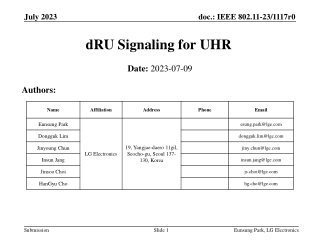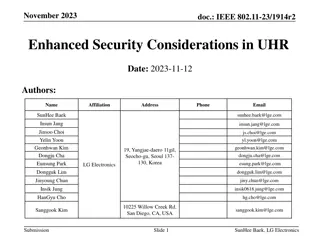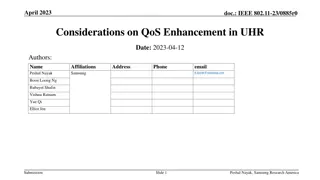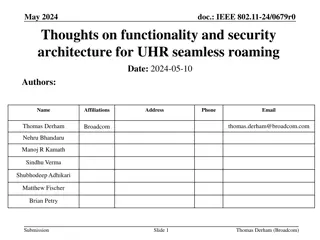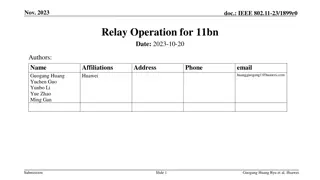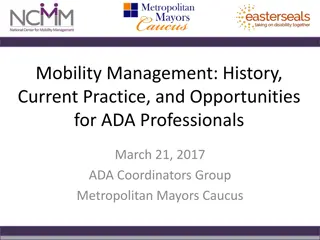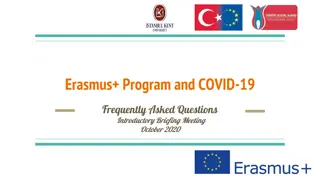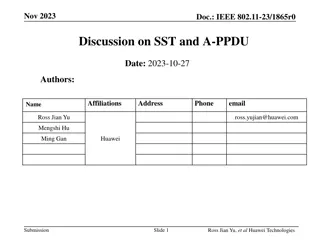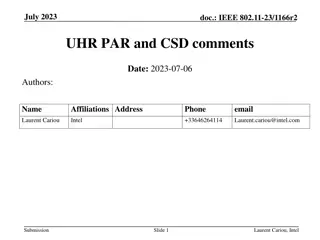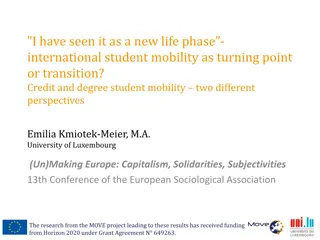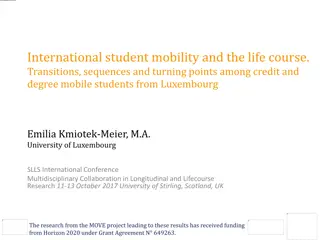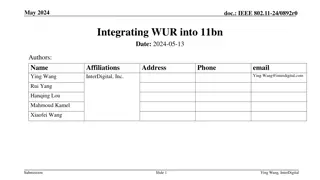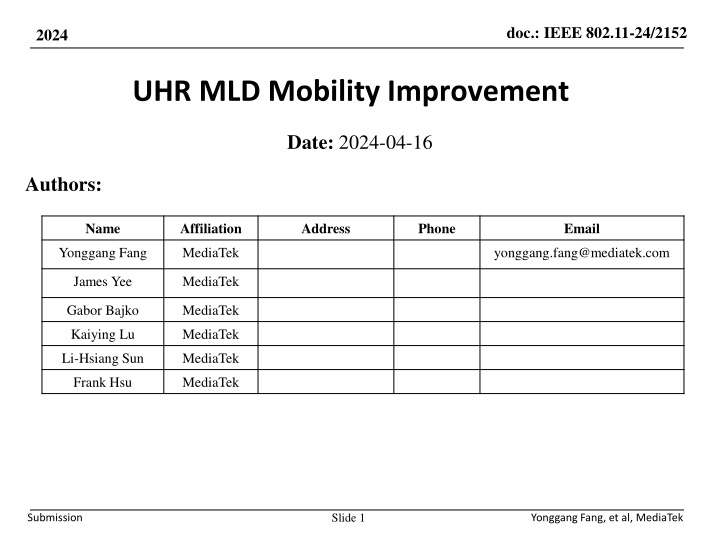
Improving Mobility in IEEE 802.11 Networks: Solutions and Performance Evaluation
Explore the challenges of mobility in IEEE 802.11 networks and solutions for enhancing roaming performance. Address issues like transition reliability, delay, and link quality to minimize service interruptions and improve user experience. Learn about roaming performance measurement and the roaming procedure in UHR MLD networks for a seamless transition between access points.
Download Presentation

Please find below an Image/Link to download the presentation.
The content on the website is provided AS IS for your information and personal use only. It may not be sold, licensed, or shared on other websites without obtaining consent from the author. If you encounter any issues during the download, it is possible that the publisher has removed the file from their server.
You are allowed to download the files provided on this website for personal or commercial use, subject to the condition that they are used lawfully. All files are the property of their respective owners.
The content on the website is provided AS IS for your information and personal use only. It may not be sold, licensed, or shared on other websites without obtaining consent from the author.
E N D
Presentation Transcript
doc.: IEEE 802.11-24/2152 2024 UHR MLD Mobility Improvement Date: 2024-04-16 Authors: Name Affiliation Address Phone Email Yonggang Fang MediaTek yonggang.fang@mediatek.com James Yee MediaTek Gabor Bajko MediaTek Kaiying Lu MediaTek Li-Hsiang Sun MediaTek Frank Hsu MediaTek Slide 1 Submission Yonggang Fang, et al, MediaTek
doc.: IEEE 802.11-24/2152 2024 Introduction This contribution discusses mobility improvement in in UHR MLD networks. 2 Submission Yonggang Fang, et al, MediaTek
doc.: IEEE 802.11-24/2152 2024 Motivation Mobility Issues In a typical home or enterprise WLAN, multiple access points (APs) are used to improve the radio coverage of a single AP. A STA may experience issues of roaming among APs: Transition Reliability: Failure to establish a stable connection to a target AP Transition Delay: (1) re-authentication (2) re-association with a target AP, causing tens to a hundred of milliseconds of delay of access service Transmission Delay/Lost: the buffered data may be delayed beyond QoS requirement or lost due to transition delay Link Quality: the new connection to the target AP may not have sufficient QoS for the roaming STA. Service Impacts Roaming can cause a service interruption of application in upper layers Degrade QoS and QoE, especially for time sensitive applications. 3 Submission Yonggang Fang, et al, MediaTek
doc.: IEEE 802.11-24/2152 2024 Motivation Objectives and Possible Solutions Define a measurement for roaming performance Verify a target AP reachability to improve roaming transition reliability Improve roaming stability 4 Submission Yonggang Fang, et al, MediaTek
doc.: IEEE 802.11-24/2152 2024 Roaming Performance Measurement Roaming failures failure to setup the connection to a target AP the transition delay beyond the QoS delay bound of MSDUs transmission reliability less than the QoS reliability requirement during roaming Roaming success ratio (1 (the total number of roaming failures / the total number of roaming at a given period) ) x 100% 5 Submission Yonggang Fang, et al, MediaTek
doc.: IEEE 802.11-24/2152 2024 UHR MLD Roaming Procedure An Example of Roaming Stages Stage 1: non-AP MLD gets neighbor AP(s) information, including traffic load, traffic latency (DL/UL), link reliability ratio. Stage 2: non-AP MLD selects best reachable AP(s), re-configure and enable the link of target AP(s). Stage 3: non-AP MLD performs data frame exchanges with the source and/or the target AP(s). Stage 4: non-AP MLD disables the link to the source AP(s) when it is not reachable or reliable. Non-AP MLD Stage 4 Stage 3 Stage 2 Stage 1 Disable the link to the source AP when it is not reachable or reliable Communicate with the source AP and/or target AP (1) Select the best target AP(s) Discovery of target APs AP1 (Source) (2) Reconfigure and enable the link(s) to the target AP(s) AP2 (Target) 6 Submission Yonggang Fang, et al, MediaTek
doc.: IEEE 802.11-24/2152 2024 Roaming Transition Reachability & Reliability Improvement Reachability & Reliability in Transition Reachability: a target AP on same/different channel is reachable. Reliability: the transmission on a link is reliable especially in OBSS case. Target link quality: has sufficient QoS for applications on the roaming STA. Stage 1: An AP may have multiple neighbor APs. A neighbor AP of the serving AP to the STA may not be a candidate AP that the STA to roam to A serving AP needs to provide more information of potential candidate APs to the STA to assist the roaming procedure Proposal Provides candidate neighbor AP(s) information, including traffic load, traffic latency (DL/UL), reliability ratio In unicast management frames, or In Beacon frames AP MLD4 AP MLD5 AP MLD3 AP MLD0 AP MLD6 AP MLD2 AP MLD1 AP MLD0 has 6 neighbors. 2 candidate neighbors for the non- AP MLD 7 Submission Yonggang Fang, et al, MediaTek
doc.: IEEE 802.11-24/2152 2024 Roaming Transition Reachability & Reliability Improvement Stage 2 & 3 A roaming STA performs frame exchanges with the source AP(s) to setup a connection to the target AP on same or different channel. The roaming transition to the target AP may happen at the time different from the time of target link setup High possibility of roaming failure may be caused by radio condition, like interference, lower RSSI/SNR, busy on target AP, etc. Proposal Roaming STA performs control frame exchange with target AP(s) to verify the link reachability and reliability to the target AP before data frame exchanges with the target AP in the roaming transition. Source AP Target AP Setup a connection to target AP Frame exchange to verify the reachability & reliability 8 Submission Yonggang Fang, et al, MediaTek
doc.: IEEE 802.11-24/2152 2024 Roaming Transition Stability Improvement Roaming Stability A roaming non-AP MLD may frequently roam-in & roam-out among APs. This may cause transmission performance degradation and network congestion. Proposal Define roam-in and roam-out thresholds to control frequent link reconfiguration or update, and frequent roaming transitions. The roaming thresholds are sent through APs to a non-AP MLD. A non-AP MLD performs ML Reconfiguration/Update, and transition accordingly. AP1 AP2 AP1 AP2 AP1 AP2 Non-AP MLD Non-AP MLD Non-AP MLD Before Roaming-In Frequent Roaming-In & Roaming-Out After Roaming-Out 9 Submission Yonggang Fang, et al, MediaTek
doc.: IEEE 802.11-24/2152 2024 Summary This contribution discusses UHR mobility improvement Define roaming performance measurement Improve roaming success via checking reachability and reliability Reduce frequent roam-in and roam-out among AP MLDs Submission Yonggang Fang, et al, MediaTek


